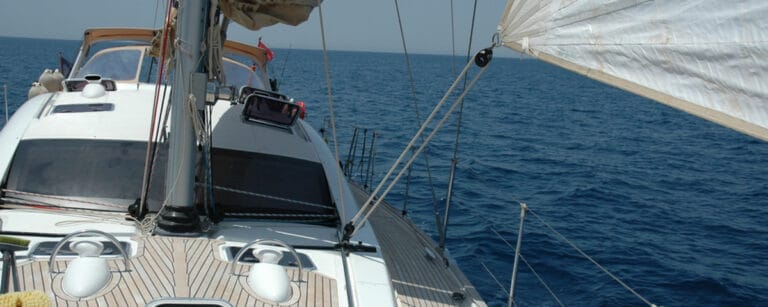TRIM and FLAPS: Optimize your navigation and fuel consumption on a motorboat
Understanding Trim and Flaps for Boat Handling
Understanding Trim
Trim is used on outboard and Z-drive motorboats to adjust the engine’s angle relative to the transom. On smaller engines, this is done mechanically. On engines exceeding 25 horsepower, it’s achieved using a hydraulic cylinder positioned between the engine shaft (called the “fût”) and the boat’s transom. It’s an attitude corrector that should be adjusted based on sea conditions and speed. It’s particularly useful when getting the boat on plane.
Proper Usage
Using trim is straightforward. A button on the throttle control allows you to vary the engine’s inclination relative to the transom. This change in position causes a deflection of the water flow, which affects the boat’s attitude. Raising the trim (UP button) moves the engine away from the transom, causing the boat’s bow to rise. Conversely, lowering the trim (DOWN button) brings the engine closer, lowering the bow. Most dashboards are equipped with a position indicator to show the trim’s setting. The trim has a limited range of motion. It should not be confused with the tilt, which allows you to raise the engine completely out of the water.
There’s no predefined setting; it all depends on the boat, its engine, and the sea conditions. However, some guidelines can help you manage it effectively. When starting, it’s beneficial for the boat to get on plane quickly. However, this can lead to rapid bow rise and loss of control. This is where trim is very useful. By setting it negatively (engine tilted inward), the boat remains horizontal and gets on plane quickly. Then, adjust it according to the sea conditions. In calm seas, set the trim positively (engine tilted outward) to raise the boat’s bow. This improves the boat’s glide and reduces fuel consumption. Raising the bow reduces the wetted surface, increasing speed. However, be careful; if the value is too positive, the boat requires precise steering and can become uncomfortable and unstable. If the situation becomes critical, slow down and lower the trim (DOWN).
The direction of the sea should also be considered. In following seas, a boat tends to point its bow down and even bury it in the wave. In this case, raise the bow by setting the trim positively. In head seas, a boat can become uncomfortable. Lower the bow by setting the trim negatively to press the engine against the transom. This prevents excessive bow rise and reduces pounding. However, too much negative trim increases the risk of burying the bow. In choppy conditions, the setting that provides a good balance between speed and stability is neutral. In this position, the anti-ventilation plate of the lower unit is parallel to the hull.
Finally, consider turning. On most engines, the propeller draws air, resulting in a loss of efficiency. Anticipate the turn by setting the trim negatively to immerse the propeller as much as possible in the water.
Key Takeaways on Trim Usage
There’s no general rule; each boat is unique. Hands-on experience is essential: navigate in calm water and try different trim settings when getting on plane, at different speeds, and when turning. Then, experiment in different sea conditions. A well-adjusted trim ensures safety, comfort, and optimized fuel consumption. A properly inclined engine can reduce engine speed by several hundred RPM while maintaining the same speed. The trim position indicator is useful for returning to good settings, especially when entrusting the helm to someone unfamiliar with the boat.
Flaps
Flaps complement the trim. They are present on most boats over 12 meters, but models are available for all boat sizes. They don’t act on the engine’s inclination like trim, but on the hull’s inclination. They consist of adjustable plates fixed to the transom’s end, extending the hull. These plates, which can be tilted up and down, allow you to modify the boat’s longitudinal and lateral attitude. They are operated by electric (or hydraulic) cylinders controlled by a panel near the helm. Their action is to modify the water flow at the stern of the hull.
Their Influence on the Boat’s Attitude
Depending on their settings, you can modify the longitudinal or lateral attitude. In the first case (longitudinal), control the flaps simultaneously so that the inclination angles are identical. Then, the adjustment is similar to that of trim, adapting their position according to sea conditions, speed, and the boat’s load. However, their action is most significant for lowering the boat’s bow and less sensitive for raising it. To act on the lateral attitude, control the flaps separately, allowing you to adjust the list. This capability is the most useful. It compensates for the propeller’s torque effect and, above all, compensates for the list in cross seas or swells. With this system, you can achieve perfect boat balance.
Automatic Models
Automatic models are available. These continuously adjust the boat’s attitude, considering not only sea conditions but also, using a gyroscope or even an accelerometer, all modifications, including changes in onboard loads (water and fuel consumption), speed, and even the movement of people.
Key Takeaways on Flaps
Flaps are a valued piece of equipment on motorboats. They not only improve onboard comfort but also significantly affect fuel consumption. There’s no universal model. The choice is made based on the boat’s specific data. You must consider the hull type (planing, semi-planing, displacement), engine type (outboard, Z-drive, or inboard), the number and power of the engines, the boat’s length and weight, etc.
Enjoyed this post by Thibault Helle? Subscribe for more insights and updates straight from the source.







